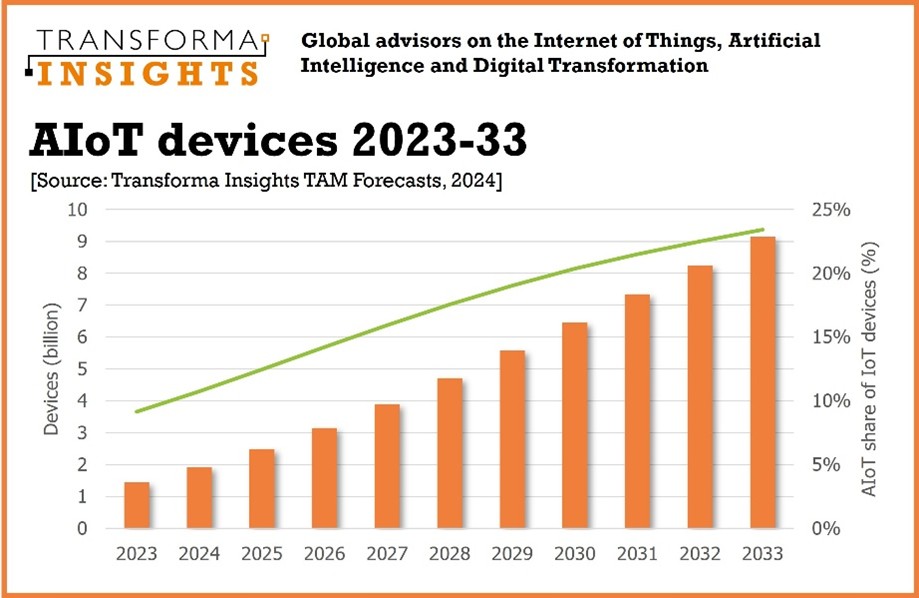Blogs
03 June 2025
Reading Time: 4 mins
Blogs
03 June 2025
Reading Time: 4 mins

Eseye
IoT Hardware and Connectivity Specialists
LinkedInIoT has always been about connections between devices, systems, people, and platforms. But the nature of those connections is evolving. As artificial intelligence (AI) intersects with the Internet of Things, a new era of intelligent, adaptive, and autonomous systems is emerging. This fusion is called AIoT and it’s more than just a buzzword. It’s reshaping the rules of engagement for IoT deployments everywhere.
We’re moving beyond reactive networks and static logic. In their place, AI introduces a dynamic, intelligent decision layer that unlocks new levels of performance and resilience. As we noted in our 2025 IoT and Telecoms Predictions report, we see AI’s greatest potential in three core areas of IoT: the device level, the application layer, and the networking layer.

Traditionally, IoT devices were designed to capture and forward data to the cloud, where it could be processed and analyzed. But that model introduces latency, drains bandwidth, and often limits responsiveness.
With AI, IoT devices can now process data directly on the hardware. This is a game-changer. Instead of acting as passive data collectors, devices become active participants, capable of detecting anomalies, initiating responses, and maintaining performance without external instruction.
This is the foundation of real autonomy. Take Eseye’s AnyNet SMARTconnect™ on-device connectivity software which can enable machine learning and AI to power its rules engine so the device can intuitively react and remediate any connectivity issues and use the most appropriate RAT for maximum connectivity performance.
The implications are vast. This shift not only reduces cloud dependence but also enables more scalable, resilient, and responsive deployments. In sectors like industrial automation, transportation, and smart cities, this edge intelligence unlocks new use cases where latency and uptime are non-negotiable.

As more intelligence moves to the edge, the application layer becomes the brain of the operation, coordinating logic, learning from data, and powering real-time decisions.
AI enhances this layer in three critical ways: repeatability, auditability, and automation. Together, these capabilities build trust. Businesses can rely on AI not just for fast decisions, but for transparent and explainable ones.
This is particularly valuable in industries like healthcare, where real-time responsiveness must be balanced with accountability. Consider CCTV systems: AI is now being trained to detect anomalous behavior and trigger alerts automatically. These AI-driven systems operate 24/7, learning and refining their capabilities over time, while providing clear logs of actions taken.
Closed-loop systems, where AI not only detects issues but acts to correct them are now a reality. From predictive maintenance in factories to personalized medicine in healthcare, AI is reshaping how we design and manage IoT applications.

Perhaps the most transformative role for AI lies in the connectivity fabric that underpins every IoT deployment.
Today’s networks are complex and fragmented. Devices roam across operators, radio access technologies, and geographies. Managing this manually or through pre-set logic is no longer sustainable. AI provides a smarter alternative.
In the years ahead, AI will orchestrate multi-operator, multi-RAT connectivity in real time by analyzing device context, network state, and quality of service to dynamically select the best route for each packet of data.
This isn’t just load-balancing. It’s a unified, adaptive intelligence layer that understands competing priorities such as latency, bandwidth, cost, coverage—and makes decisions based on real-time conditions. In a federated network environment, this could mean seamless transitions between operators and even technologies, all managed autonomously.
For mobile network operators (MNOs) and enterprises alike, this opens new strategic opportunities: from network self-healing to user-specific service levels.

The promise of AIoT lies not just in efficiency but in transformation. We’re shifting from systems that react to instructions to networks that understand, predict, and act.
Imagine:
But getting there won’t happen overnight. It requires high-quality training data—both from devices and from networks—to develop models that can make accurate decisions under varied conditions. Building this intelligence is a journey, not a single deployment.

AIoT isn’t a future aspiration. It’s fast becoming a competitive imperative. Analysts at Transforma Insights forecast over 9.1 billion AIoT connections by 2033.
For businesses looking to stay ahead, now is the time to implement AI into your IoT strategy.
Whether it’s embedding intelligence into devices, automating application logic, or orchestrating adaptive connectivity, the goal remains the same: to unlock more value, more reliably, and at greater scale.
At Eseye, we’re helping enterprises across the globe take that next step, building smarter systems that anticipate needs, solve problems, and stay connected wherever they are.
Download our AIoT white paper to see how AI brings real-time insights, automation, and smarter connectivity to IoT.
Download whitepaper